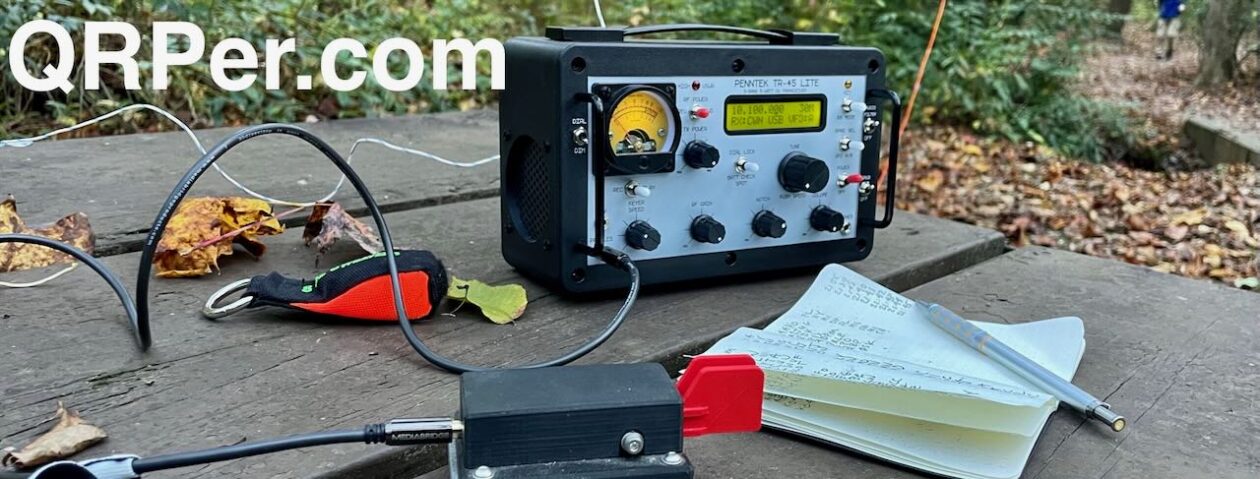Sunday, May 18, 2025, was the final day of Hamvention. It’s typically the slowest day, and I’ve even been known to skip it in favor of doing POTA with friends instead.
This particular Sunday, though, my dear friend Vince (VE6LK) was giving a mid-morning presentation about building go-boxes, so Eric (WD8RIF), Miles (KD8KNC), Len (W8VQ), and I headed to the Greene County Expo Center to attend.
Vince’s presentation was well-attended—most impressive for a Sunday morning!
As tempting as it was, I didn’t abscond with any of Vince’s radio kit!
Carillon Historic Park
 Around 12:30, Eric, Miles, Len, and I left Hamvention and ventured into Dayton. We planned to do an activation at one of the Dayton Aviation Heritage National Historical Park sites (US-0732).
Around 12:30, Eric, Miles, Len, and I left Hamvention and ventured into Dayton. We planned to do an activation at one of the Dayton Aviation Heritage National Historical Park sites (US-0732).
Eric chose Carillon Historical Park as our activation site for US-0732. It’s an ideal POTA spot in many respects, with a large open field, several trees, and plenty of parking. That said, when we pulled into the site, we realized there was a public event underway and the parking lot was nearly full.
 Fortunately, the parking attendants motioned us to park in a field close to where we would set up our stations. The music event was taking place on the far side of the park, so it didn’t interfere with our activation.
Fortunately, the parking attendants motioned us to park in a field close to where we would set up our stations. The music event was taking place on the far side of the park, so it didn’t interfere with our activation.
 Eric, Miles, and Len made their way to a clearing and set up my Chelegance MC-750 antenna.
Eric, Miles, and Len made their way to a clearing and set up my Chelegance MC-750 antenna.
 I picked a broad maple tree that provided a perfect shady spot for my station. The canopy not only kept me cool, but also offered a bit of stealth—not that stealth was necessary at this site, but with so much activity in the park, I wanted to keep my entire station contained in a safe, tidy space that wouldn’t trip up children running around nearby.
I picked a broad maple tree that provided a perfect shady spot for my station. The canopy not only kept me cool, but also offered a bit of stealth—not that stealth was necessary at this site, but with so much activity in the park, I wanted to keep my entire station contained in a safe, tidy space that wouldn’t trip up children running around nearby.
I set up my Helinox chair next to the trunk and deployed my throw line nearly vertically using the “granny shot” method—a technique I rarely use. It took two tries to get the line placed in a way I felt would support the antenna well. By shooting the line upward from underneath the canopy, both the antenna and throw line stayed in a tight footprint right beside me and entirely under the tree.
My antenna
 Speaking of antennas, I was using a homebrew end-fed random wire sent to me by one of my readers and subscribers, Bryan (AD8HK). I believe Bryan may eventually offer a variation of this design commercially, but at present it’s still in development. He sent me this one purely for evaluation.
Speaking of antennas, I was using a homebrew end-fed random wire sent to me by one of my readers and subscribers, Bryan (AD8HK). I believe Bryan may eventually offer a variation of this design commercially, but at present it’s still in development. He sent me this one purely for evaluation.
 This particular antenna features a 9:1 transformer with a 17 ft 9 in radiator and an 8 ft 10.5 in counterpoise. With a wide-range ATU—like the one built into my KX2—it matches from 40 meters and up.
This particular antenna features a 9:1 transformer with a 17 ft 9 in radiator and an 8 ft 10.5 in counterpoise. With a wide-range ATU—like the one built into my KX2—it matches from 40 meters and up.
With my full station deployed, it was time to hit the air and see if the ionosphere had any charge left in it.
Gear
 Note: All Amazon, CW Morse, ABR, Chelegance, eBay, and Radioddity links are affiliate links that support QRPer.com at no cost to you.
Note: All Amazon, CW Morse, ABR, Chelegance, eBay, and Radioddity links are affiliate links that support QRPer.com at no cost to you.
Radio
Antenna & Supports
- AD8HK Homebrew End-Fed Random Wire with 17ft 9in radiator and 8ft 10.5in counterpoise
Cable Assembly
Throw Line and Accessories
Other Field Gear and Accessories
Packs & Cases
Logging Supplies
Camera/Audio Gear
- DJI OSMO 4 action camera with Joby Telepod Sport Tripod
- DJI Wireless Microphones
On The Air
 Band conditions during Hamvention weekend were pretty dismal. I’ll admit, I was fully prepared to call CQ for a couple of hours, if necessary, to complete the activation (Eric felt the same way). We had no other plans for the afternoon, so time was on our side.
Band conditions during Hamvention weekend were pretty dismal. I’ll admit, I was fully prepared to call CQ for a couple of hours, if necessary, to complete the activation (Eric felt the same way). We had no other plans for the afternoon, so time was on our side.
The great thing about pairing a small random wire antenna with my KX2 is the incredible frequency agility I get using its internal ATU. And during this particular activation, I definitely needed it. Continue reading Post-Hamvention POTA: A Challenging but Relaxing Activation with Friends in Dayton



























































































































